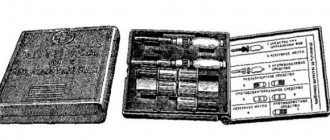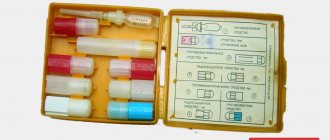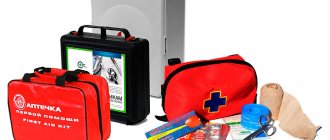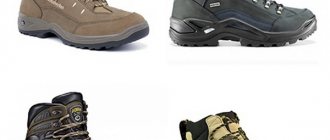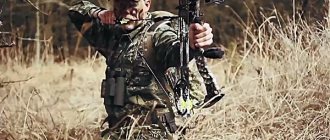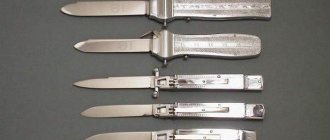Active recreation is becoming increasingly popular. Expeditions, tourist trips, rafting, mountaineering trips, alone or in a group, are often associated with traumatic or extreme cases when medical care is urgently needed.
The nearest settlement is far away, there is no mobile network reception - what to do in such a situation? It’s good if the group of travelers includes a traveling doctor or a person with medical education, but what if he doesn’t? In this case, a traveling first aid kit will help provide the necessary assistance to the victim and wait for qualified assistance. Therefore, when going on a long (or not so long) trip, you need to properly assemble a first aid kit or purchase a ready-made, complete version. In the article you will find answers to the questions: what should be in a first aid kit for a tourist and how to determine the required amount of contents?
Choosing a first aid kit
Tourist first aid kit
It is a must-have element for various country trips. However, it is difficult for a person far from medicine to understand the whole variety of existing medications and dressings and fixing materials. In addition, taking the wrong medicine or taking a larger dose than necessary can only worsen the victim's condition.
A tourist’s first aid kit can be purchased in a ready-made version, which contains all the necessary and non-harmful medications and materials, with detailed instructions. However, you still have to deal with the contents. It is possible that there will be a need to supplement the content depending on the size and composition of the tourist group. You may also find the material on the procedure for registering tourist groups useful.
If you decide to assemble a traveling first aid kit with your own hands, then consider the following rules:
- All medications must be classified as urgent, that is, their action is aimed at eliminating acute conditions (poisoning, fever, heart attack)
- The dressing should cover the entire group of injuries: from a small cut to a severe fracture (you can see the rules for first aid for fractures in the video presented)
- These drugs should be accessible, that is, they can be easily purchased at any pharmacy without a prescription.
- Give preference to those medications that you have already encountered. This will protect you from possible side effects.
- Do not buy advertised drugs, their effect may be exaggerated. In most cases, their cheaper counterparts are no worse.
The specific contents of the hiking first aid kit will also depend on the type and category of the hike (water, mountain, forest, extreme), duration, age of the participants, time of year
In the case when the group includes a person who has permission (certificate) to perform injections, then the contents can include ampoules for injections and syringes of various sizes.
Small travel first aid kit
On short hikes near populated areas where qualified medical care can be provided, you can take a small first aid kit. The list of means and materials that should be included in its composition, in such cases, is limited to medications for providing simple medical care:
- Bandage: sterile and non-sterile (1 piece is enough for a group of 10 people).
- Elastic bandage (2 pcs.).
- Tourniquet.
- Hydrogen peroxide and iodine.
- Potassium permanganate (a few grains of potassium permanganate can be thrown into boiled water from an open source, and the water will become suitable for consumption).
- "Albucid" - drops for the treatment of conjunctivitis, which have a pronounced bactericidal effect and can also be used to treat a runny nose. The medicine is not harmful when used by pregnant and lactating women, as well as for newborns. Analog – sodium sulfacyl.
- "Panthenol" (remedy for burns).
- "Validol" (for heart pain and stress).
- Ammonia (ammonia) is an emergency treatment for fainting.
- Broad-spectrum pain reliever.
- "Citramon" (headache remedy).
- "Fenkarol" (medicine for allergies and allergic dermatoses).
- “No-spa” (broad-spectrum antispasmodic).
- "Bellalgin" (used as part of symptomatic therapy for heartburn, intestinal colic, abdominal pain).
- Scissors.
- Cotton wool in alcohol. In a small jar that closes tightly, you need to put 20-30 pieces of cotton wool and fill it with alcohol until it is very wet. The pieces will be easy to separate from each other when needed.
Packaging requirements
Camping first aid kit
In addition to the composition, the packaging itself plays an important role. Medicines must be stored under certain conditions. They should not be exposed to sunlight or moisture, and they do not tolerate high temperatures well. Compliance with storage conditions is especially important for ampoules with injection solutions. During a hike, a first aid kit that does not meet the requirements may become unusable and the materials it contains will lose their effectiveness.
The first aid kit must have packaging that meets all of the following requirements:
- Tightness. Even if you drop the first aid kit into water, not a single drop should get inside.
- Rigidity. The packaging should not be deformed when carried in a backpack, shaking, or shock. Many plastic containers meet this requirement.
- Lock security. Under any conditions, it should open easily and simply snap into place. Pay attention to the connection between the lid and the box.
- The presence of shock-absorbing inserts. They will protect glass and plastic packaging of medicines from damage if dropped from a height.
- A light weight. It is better to give preference to lightweight packaging.
- All medications must be labeled with the name and expiration date
- For ease of hand carrying, the first aid kit can be equipped with a handle or strap.
- The presence of large bright markings in a visible place indicating its purpose.
To quickly find the right medicine, it will be optimal if the inside of the container is divided into several blocks. Be sure to make a list with a list of all contents and small recommendations for reception. Medicines with an expiring date, or for which it is unknown, do not need to be placed in a travel first aid kit.
Cover medications in glass vials with adhesive tape for greater safety. The only exception is ampoules. It is better to pack them in an additional unbreakable container.
It is better to combine medications of the same action together. For example, put all absorbents in one block, and painkillers in another. If there are no divisions in the first aid kit, you can connect them together with an elastic band.
What should you choose: a store-bought first aid kit or one you can assemble yourself?
Pharmacies can offer you a choice of ready-made travel first aid kits in convenient packaging with compartments. However, there are important nuances:
- The list of medications in such collections is far from complete; it mainly includes dressings and medical instruments. Medicines have to be purchased additionally.
- Individual characteristics are not taken into account. Manufacturers of first aid kits cannot know what diseases their potential buyer suffers from, so you will have to take care of personal medications yourself.
- Packaging does not always meet all requirements. It can be soft, not airtight, without a thermal insulation layer.
Thus, it makes sense to purchase a ready-made tourist first aid kit if its packaging is convenient and safe, but you will still have to purchase medicines in accordance with the individual needs of each member of the group on your own.
Personal first aid kit
On a hiking trip that has a category of difficulty or that is designed for a long period of time, each participant must have an individual first aid kit. It includes the necessary medications prescribed for this person, as well as the simplest means that will allow you to provide first aid in case of injury.
In most cases, the list of personal first aid kit includes:
- Bandage or dressing package for individual use;
- Antiseptics (iodine, brilliant green, hydrogen peroxide);
- Bactericidal and waterproof patches (several packs);
- Painkillers (analgin, citramon)
- Cotton pads
- Protective skin cream and chapstick
- Individual medications for the presence of any chronic diseases.
The group leader is informed that the hiker must take certain medications.
List of standard camping first aid kit
On every group trip there is always a first aid kit. A tourist first aid kit is a mandatory group equipment; it is a voluminous plastic box weighing 2-3 kg. The first aid kit contains a set of medicines and first aid supplies for the most common diseases and injuries on hikes.
Below is a list of our standard camping first aid kit (edited for the 2021 season). Slight changes in the names of drugs are possible, since some of them have many analogues and trademarks.
| Dressings and auxiliary materials | Sterile bandage, Sterile wipes, Bactericidal plaster, Wide plaster (roll), Thermometer, Rubber tourniquet, Sterile gloves, Syringes, Cotton swabs, Cotton wool, Cooling bag “Snowball”, Scissors. |
| Allergy | Suprastin in tablets and ampoules |
| Pain | Ketanov in tablets and ampoules, Citramon, No-Shpa |
| Herpes | Acyclovir |
| Eyes | Sulfacyl sodium (albucid) |
| Throat | Faringosept, Furacilin, Ambroxol, Hexoral |
| Diarrhea | Loperamide, Phthalazol |
| Constipation | Magnesium sulfate |
| Infection | Levomycetin, Amoxicillin |
| Runny nose | Naphthyzin |
| Burns | Panthenol |
| Poisoning | Activated carbon, Regidron |
| Kidneys | Lasix, 5-nock |
| Wounds | Rescuer, Hydrogen Peroxide, Chlorhexidine, Levomekol, Iodine, Zelenka |
| Heart | Nitroglycerin, Valerian in tablets |
| Fever, cold | Paracetamol, Analgin, Tera-Flu, ascorbic acid, Zvezdochka balm |
| Bruises, sprains | Viprosal, Troxevasin, elastic bandage |
| Shock | Dexamethasone in ampoules |
It is advisable for each participant in the hike to have a personal tourist first aid kit, which should include: individual bactericidal adhesive plasters (5-10 pcs), for mountain hikes an elastic bandage (1-2 pcs) or knee pads (knees often hurt due to heavy load, but put 10 bandages in a group first aid kit is not possible - they are very bulky), “favorite” pills and medicines.
If you have chronic diseases, and you also know that you are often susceptible to one or another disease, be sure to take your usual medications. Example: chronic runny nose - take the usual drops with you, frequent sore throats - take proven remedies that help you, etc. There may not be specific or rare drugs in the medicine cabinet.
On serious mountain hikes, it is useful to take a pack of effervescent vitamin C (dosage 1000 mg) - it will support the immune system and help the body cope with difficulties more easily. Vitamins can be dissolved in a bottle of water and drunk throughout the day, tasty and healthy!
Be healthy on your hike and always!
Travel first aid kit (small)
Traveler's first aid kit
This version of the first aid kit is considered shortened. It is used when the trip lasts no more than two days or the excursion takes place in populated areas where it is possible to provide qualified assistance.
The list of drugs includes only the most necessary drugs and simple materials.
- Medicines for problems arising with the gastrointestinal tract. These are absorbents (activated or “white” carbon), antidiarrheals, antispasmodics (no-spa, spasmalgon)
- Painkillers. It is advisable to take several names, since everyone’s sensitivity to the effects of drugs is different.
- Dressing materials and means of fixing the damaged joint
- Disinfectants and antiseptics. On the road, iodine and brilliant green preparations in the form of a pencil or felt-tip pen are very convenient. You can purchase medical glue and topical hemostatic agents (hemostatic sponge).
- Plaster of various shapes.
- First Aid Burn Spray
- Antihistamine tablets (for allergies)
This list is not exhaustive. It can be expanded depending on the age category of the tourist group. If there are elderly people among the participants, then you can take cardiac medications (Valocordin).
Basic composition of a first aid kit
During a hike, both minor injuries and serious illnesses can occur. That is why the basic composition of the first aid kit should contain all the necessary drugs and additional supplies.
The following groups of drugs are basic in the camp first aid kit::
- Antiseptics. They are necessary for treating wounds and abrasions,
- Painkillers. They are used when pain syndromes of various nature occur,
- Antipyretic. Reduces high body temperature,
- Enterosorbents are used for poisoning,
- Antidiarrheals are used for intestinal disorders (diarrhea).
When getting ready for a hike, it is mandatory to take dressing materials.
Disinfectants (antiseptics)
During a hike, various wounds and open injuries are inevitable. Therefore, a tourist’s first aid kit must include at least one of the following disinfectants:
- Hydrogen peroxide is the most accessible antiseptic. It is easy to find at the pharmacy and is inexpensive. Peroxide can be used to treat the wound cavity itself. It has hemostatic properties (stops bleeding),
- Chlorhexidine bigluconate 0.05% solution or Chlorhexidine. It is destructive to many pathogenic microorganisms, so its range of applications is wide. Treatment of wounds with Chlorhexidine is painless and effective,
- Rubbing alcohol or alcohol wipes. This antiseptic may be needed when performing injections, as well as for treating the edges of wounds,
- Miramistin is a modern broad-spectrum antiseptic. They can be used to irrigate the wound cavity, mucous membranes and skin.
Dressing materials
The hike is unpredictable and dressings are necessary. It will be needed when applying a bandage to an open wound, fixing a joint and limb, and stopping bleeding (pressure bandage).
Your travel first aid kit should contain the following dressing material::
- Sterile bandages and sterile bandage wipes. They must be hermetically packaged in original packaging; if its integrity is damaged, the material is considered non-sterile. They are used to treat the cavity of an open wound and the soft tissue surrounding it, as well as to apply an aseptic dressing,
- Bactericidal patch. It is sterile and is used as a standalone bandage on small areas of the body, and to secure sterile material in the area of an open wound,
- Cotton wool or cotton balls. For treating skin with antiseptics
- Non-sterile bandages. They are used for applying pressure (for minor bleeding) and tight (for injuries: bruise, dislocation, sprain) bandages, fixing compresses,
- An elastic bandage is used to fix an injured limb or joint.
Painkiller and antipyretic
To get rid of the pain of fever while hiking, you should have painkillers, antipyretic (antipyretic) drugs.
List of medications in a backpacker’s first aid kit that can cope with these problems:
| Group of drugs | A drug | Effect of the drug |
| Analgesic | Analgin, an old generation drug, has many side effects | Elimination of pain of low and medium intensity. |
| Analgesic | Ketanov | Elimination of intense pain of various etiologies (headache, dental, traumatic) |
| Analgesic | Baralgin | Good and fast analgesic effect |
| Antispasmodics | No-spa and Papaverine have the same effect on the body | Relieves pain caused by spasm of smooth muscles (abdominal pain, intestinal colic, menstrual pain syndrome and others) |
| Nonsteroidal anti-inflammatory drugs (NSAIDs) for internal use | Ibuprofen, Nurofen | Analgesic, antipyretic, anti-inflammatory |
| Aspirin | Analgesic, antipyretic, anti-inflammatory, antiplatelet effect (prevents the formation of blood clots in the lumens of blood vessels) | |
| NSAIDs for external use | Nise, Diclofenac | Relief of local inflammation, pain relief for various closed injuries (dislocation, sprain, bruise, ligament rupture) and joint inflammation (arthritis, osteochondrosis) |
Remedies for gastrointestinal problems
During the hike, problems with the gastrointestinal tract may arise. This may be due to the consumption of low-quality food, untreated and contaminated water, unwashed or unknown berries, fruits and vegetables. Various groups of medications can eliminate all these symptoms.
The following list of medications must be included in your travel first aid kit:
| Group of drugs | A drug | Indications for use |
| Absorbents | Activated carbon | Various intoxications. The drug prevents the absorption of toxins and removes them from the body through the intestines |
| Antiemetic | Enterosgel | Food poisoning |
| Antiemetic | Cerucal (Metoclopramide) | Nausea, vomiting, increased gas production |
| Laxatives | Rectal suppositories with glycerin | They are not absorbed in the intestines and are completely excreted in the feces. Used for any constipation |
| Laxatives | Duphalac | Chronic and acute constipation |
| Antidiarrheal | Loperamide | For diarrhea associated with indigestion |
Calculation of the amount of medicines
Hiking tourist first aid kit
Those who have decided to assemble a first aid kit with their own hands are concerned with the question - how to correctly calculate the number of drugs needed, how much to put in so that there is sure to be enough?
Typically based on the following factors:
- The most common painful conditions during hiking are poisoning of varying degrees of severity. All gastrointestinal medications must be taken in increased quantities, 1 package per 1 tourist.
- Painkillers and antihistamines - usually 0.5 packs are enough for 1 person
- When calculating dressings, use a maximum of 3 injuries. If the injuries are severe, you will most likely have to stop the hike.
- For other medications, the principle applies - packaging for 2 participants.
Don't forget to find out if tourists in your group suffer from any chronic diseases and whether they will need additional medications.
